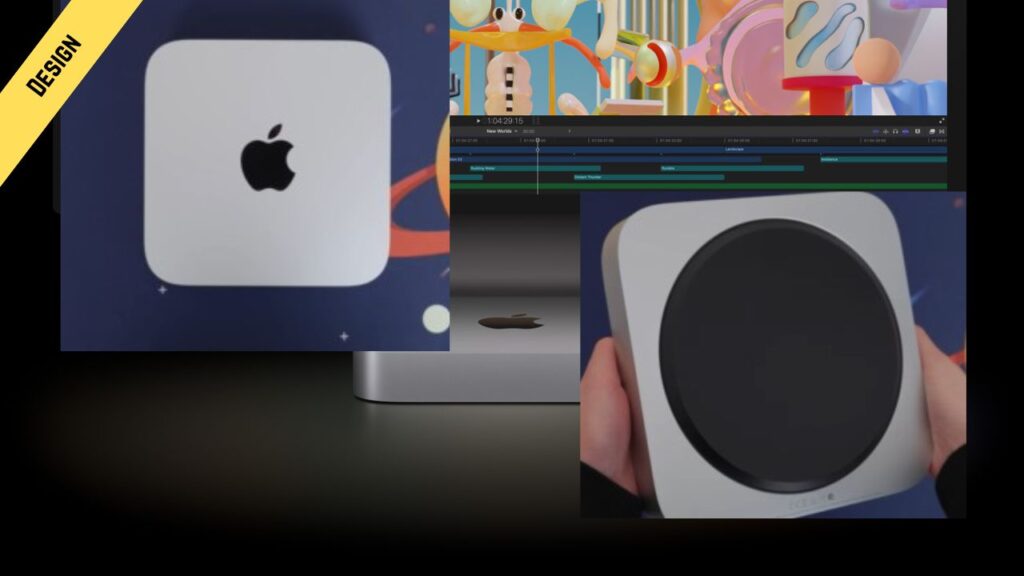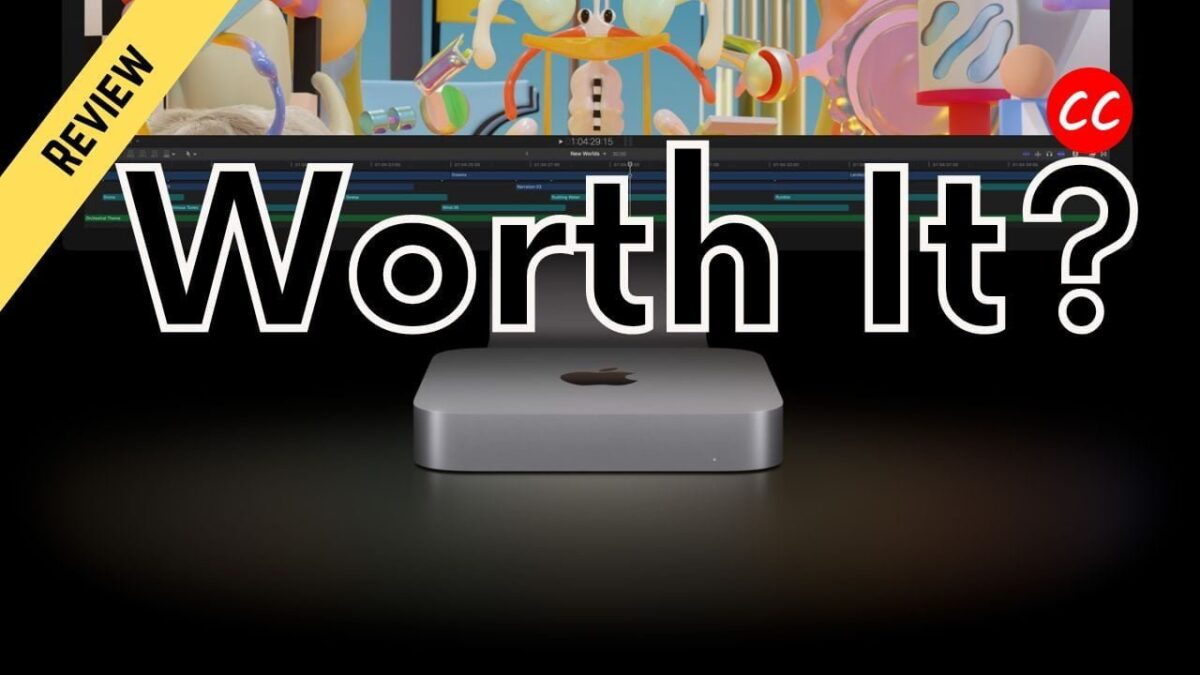The Mac Mini with the M2 Pro inside, I’ve tested this chip against MacBook Pros that are newer and those that feature the M1 Pro, M1 Max, and M2 models. There is no denying that M2 Pro chip improves single-threaded performance significantly. Furthermore, compared to the previous generation, it has three more GPU cores and two more CPU cores. However, it doesn’t scale as well as I had hoped in a few significant tasks.
Table of Contents
Note: This article contains Amazon affiliate links. If you make a purchase through these links, I may earn a commission at no extra cost to you.
Design

The design didn’t changes any, The sides have a large Apple logo prominently displayed, while the front is made entirely of aluminum. Subsequently, the rear panel comprises a monochromatic black disc bearing the inscription Mac Mini.
As you may have seen, this item is quite similar to a fingerprint; nevertheless, it doesn’t really matter because you won’t see it very often. Nonetheless, it’s excellent that the sides and top are highly fingerprint-resistant. The Mac Mini’s general form is similar to a rounded square. Although their edges are not crisp, they are unquestionably very well defined. Also, there is a tiny light to show power on this front.
Surprisingly, this M2 Pro Mac Mini includes a speaker inside even if it lacks a screen, keyboard, or batteries. I wouldn’t use that because it sounds quite horrible. It’s probably just intended to play the startup sound to let you know when it’s booting up, in my opinion. The Mac Mini comes in a single color: silver. If it came in as many distinct colors as the iMacs, I believe it would be much more enjoyable. There was just one power wire and one enormous Apple sticker inside the box the Mac Mini arrived in.
Mac Mini Ports

In terms of the physical design of the Mac Mini, one thing that surprises me is the number of ports on this M2 Pro model. It has four Thunderbolt ports, which is one more than the new MacBook Pros, but it still maxes out at three displays. Also, this year, all the new M2 Pro and Max MacBooks, as well as this Mac Mini, have an HDMI 2.1 port, so you can drive a 4K high-refresh-rate monitor from it or an 8K TV. I definitely think this is a good upgrade.
You can also get a 10-gigabit Ethernet port on this thing, which, if you need a lot of storage, is highly recommended. This way, you can have a huge amount of cheap storage on a NAS, or in my case, a repurposed PC. 10-gigabit Ethernet is fast enough to edit directly off of. In my case, I’m using SFP+ cables, but it’s the same in principle. Adding this option means that you don’t have to purchase a fairly expensive dongle separately, and it also won’t take up any of the Thunderbolt ports.

It’s also quite handy that the Mac Mini features USB-A connectors that can transfer five gigabytes of data per second. This device has all of its ports on the rear. The quantity and diversity of ports are excellent overall, especially if you utilize 10-gigabit Ethernet. However, I think it would be wonderful if some of them—especially the USB ones—were on the front like it is on the Mac Studio.
Read Also: Panasonic LZ980 48-Inch OLED TV Design
Mac Mini Performance

So, I want to point out that although the M2 Pro does have two more cores than the M1 Pro, the two extra cores are both the much less powerful efficiency cores. So, the maxed-out M1 Pro and the M2 Pro actually have the same number of performance cores. Even with the new generation of core design, it ends up only about 15% faster than the M1 Pro in multi-threaded workload on Geekbench, which is honestly still quite a big improvement. But it’s just not the over 20% gain that you would assume by just looking at the core count.

However, in some multi-threaded workloads, such as building Firefox, it actually did surprisingly well, taking around 28% less time to finish when compared against the M1 Pro and 44% less time when compared against the base M2 with only four performance cores. And in terms of single-threaded performance, the M2 Pro is really close to the M2. Depending on the task, it can be faster at times since it has a bigger RAM bandwidth. For example, in Speedometer which measures web performance, the M2 Pro does score quite a bit better than the M2 in both Chrome and Safari. It also beats the M1 Pro by 30% to 40% depending on the browser.
But honestly, I don’t really notice a difference in actual use in terms of web browsing. All these numbers are big enough that no matter how many tabs I have open or how many things I’m trying to do at once, it never feels slow on any of these machines. They’re all primarily bottlenecked by the speed of the server that hosts the websites and also your internet connection. Only really complicated websites will show a slight difference, such as loading Google Earth, where both the M2 and the M2 Pro load it noticeably faster than the M1 Pro.

But the same core performance does have some useful real-life impacts, such as applying filters in Photoshop. Here, the M2 Pro is able to get it done faster than the M1 Pro, but it’s basically the same speed as the M2 for most of the filters. So, for me as a computer science student, I don’t think picking the M2 Pro over the M2 is worth it for just programming unless you know that you will be compiling large projects often.
But most of the assignments that I did in school were single-threaded and would have run at the same speed on both the M2 and the M2 Pro. So, I think for most basic programming and general computing tasks, the M2 is likely to deliver the same experience as the M2 Pro. But for making larger software projects, the M2 Pro will give quite a nice boost to the speed.

But I believe that this time, the GPU cores will be the primary motivator to purchase an M2 Pro. It has up to 19 GPU cores, and it outperformed the M2 in the 3DMark Wildlife Extreme Unlimited test, earning more than twice as many points. And it was 25% faster than my 16 GPU core M1 Pro. Therefore, this device has excellent GPU performance on paper. However, the scaling is far less remarkable in real life.

For instance, the M2 Pro and M1 Pro required nearly the same amount of time in DaVinci Resolve and Final Cut Pro to render a straightforward 10-minute 4K video. Both of them are only 7% quicker than the M2 base model, while the M1 Max, which has 24 GPU cores, defeated them both handily.
This also holds true in DaVinci Resolve when stabilizing a one-minute clip. The M1 Pro and M2 Pro are virtually tied. Once more, this might be because the software isn’t yet tuned for the M2 Pro, but I think there’s probably another constraint at play. especially considering that Apple produces Final Cut Pro.

And speaking of other bottlenecks, I don’t think the SSD here will ever be an issue. I have the one terabyte model and it’s extremely fast. It’s not substantially faster than last gen, but it’s more than fast enough for pretty much all the things that I can think of.
Also, one huge benefit of this over a traditional laptop is how quiet it is. Here, I have it rendering a video next to my M1 Pro MacBook and it’s a lot quieter. It makes me think that even an M2 Max can definitely be cooled adequately in this type of chassis. But unfortunately, the Mac Mini only goes up to the M2 Pro. I think the M2 Max chip will probably be in the Mac Studios, but you have to wait a bit longer for those to get the new M2 series SOCs.
Mac Mini Price
Alright, so when it comes to pricing, the Mac Mini is significantly less expensive than the new 14-inch MacBook Pro—by $700, to be exact. This may or may not make the Mac Mini a better deal for you, depending on your needs—especially if you already possess a display, keyboard, and mouse. Furthermore, because of its quietness, the Mac Mini might be more enjoyable to use at home. However, the screen on the MacBook is excellent, and you cannot even get a 1600-nit high-resolution, high-refresh-rate screen for $700. For those who need portability or a high-definition screen, the new M2 laptop is a good value.
Final Thought
Overall, for those in need of GPU performance and who don’t require a portable laptop, the M2 Pro option in the Mac Mini is a good choice due to its lower cost compared to the M2 Pro in the MacBook. However, currently, the M2 Pro does not offer significantly better real-life GPU performance than the M1 Pro. It remains to be seen whether future software optimizations can improve its video rendering performance to match its GPU benchmark scores. For CPU performance, if your work mainly involves single-threaded tasks like Photoshop or programming, the M2 performs comparably to the M1, making the M2 Pro not worth it in such cases.
But if your work primarily involves multi-threaded applications like code compilation, the M2 Pro would be a significant upgrade over the M1 series and the base M2, and it is likely comparable to the M2 Max and only slightly lagging behind the M1 Ultra. Overall, the Mac Mini M2 Pro offers pretty good value in such a small box. That’s it for this video. Subscribe to watch more here.
M2 Pro Mac Mini Review
The M2 Pro option in the Mac Mini is a decent alternative for those who need GPU capability but do not need a portable laptop because it is less expensive than the M2 Pro in the MacBook. But as of right now, the M2 Pro's real-world GPU performance is not appreciably superior than that of the M1 Pro.
- Performance8.5
- Storage7.5
- Graphics8
- Ports9
- Price7.5
- Design8

